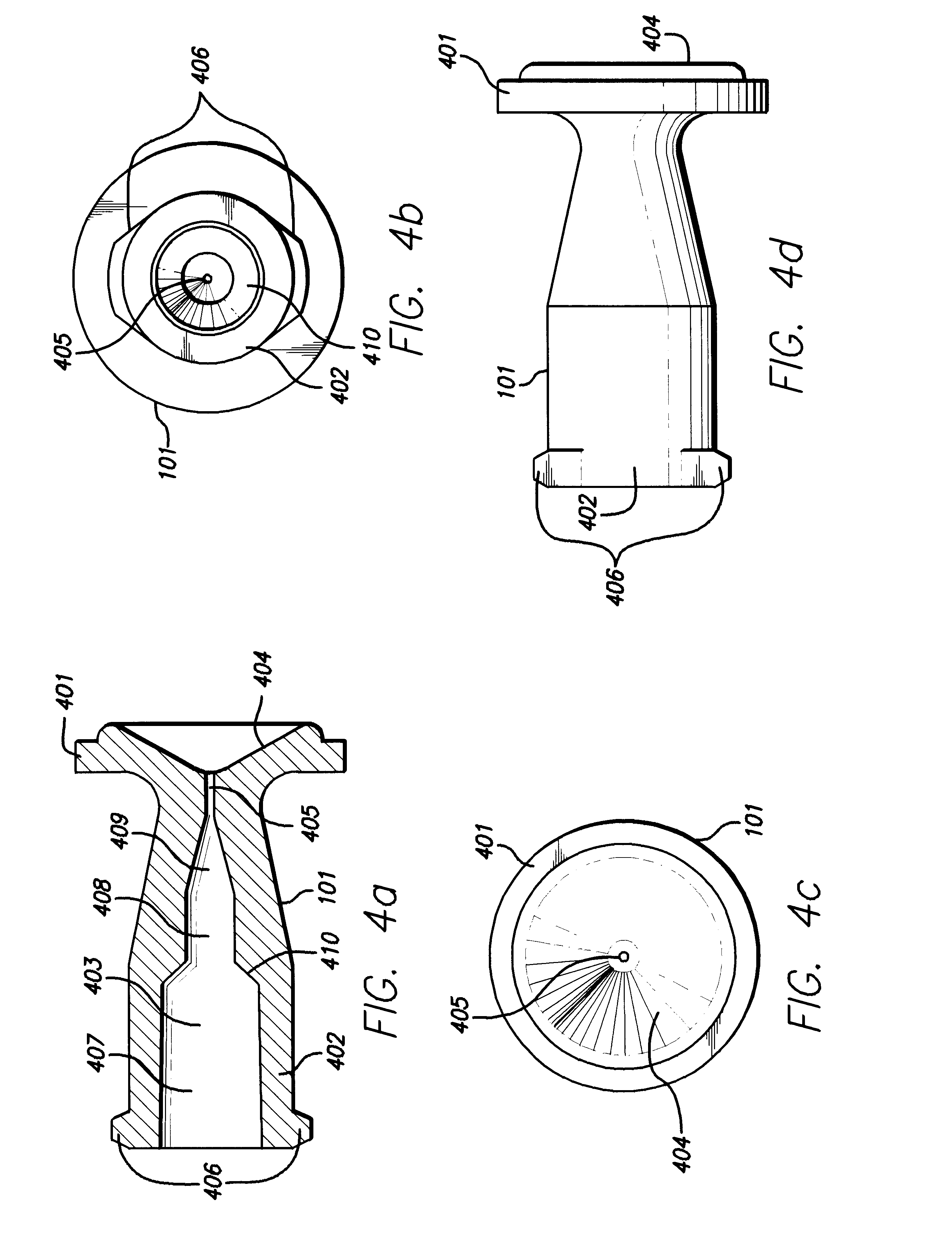Method and apparatus for filling or refilling a needle-less injector
a needle-less injector and needle-less technology, which is applied in the direction of liquid handling, packaged goods, food processing, etc., can solve the problems of increasing the danger of contamination exposure of needle injectors, severely hampering the ability of those in need of regular injections to receive convenient, and the burden on the diabetic population is larg
- Summary
- Abstract
- Description
- Claims
- Application Information
AI Technical Summary
Benefits of technology
Problems solved by technology
Method used
Image
Examples
example 2
Filling a Needle-Less Injector Using a Filling Device
A filling device includes both a vessel and a coupling device. The filling device is mated to a needle-less injector by holding the injector end of the coupling device against the receiving surface on a dispensing end of a needle-less injector. The vessel included in the filling device is a syringe, affixed to the coupling device with a snap fitting. The needle-less injector contains a lyophilized solid medication prior to filling via the coupling device, and the filling device contains a diluent.
The plunger of the filling device is depressed, forcing the diluent through the coupling device, through corresponding orifices disposed on the coupling device and needle-less injector, and into the needle-less injector. Graduations on the Luer syringe provide a user with a visual cue to determine when the desirable amount of diluent has been introduced into the injector. Upon filling the needle-less injector with the desirable amount of ...
example 3
Filling a Needle-Less Injector Using Filling Equipment
Filling equipment includes a reservoir of a pharmaceutical fluid and a series of tubes, each of which terminates with an adapter. A vessel end of a coupling device is connected to each of the adapters. A series of needle-less injectors is mated to the series of coupling devices, and an amount of the pharmaceutical fluid is filled into each needle-less injector.
After each of the needle-less injectors is filled with an amount of the pharmaceutical fluid, the coupling devices are removed from the needle-less injectors and another series of needle-less injectors is mated to the same coupling devices. An amount of the pharmaceutical fluid is then filled into each of this second series of needle-less injectors.
After each of the second series of needle-less injectors has been filled with an amount of the pharmaceutical fluid, the coupling devices are removed from the needle-less injectors, and a rubber cap is placed on each.
example 4
Preparing a Vessel for Filling a Needle-Less Injector with a Fluid Using a Coupling Device and a Storage Vial
A Luer syringe is affixed to the vessel end of a coupling device, by screwing the, elements together (i.e., two elevated tabs on the vessel end of the coupling device cooperate with interior screw threading on the Luer syringe). The cap is removed from a storage vial, and the storage vial is attached to the injector end of the coupling device, also by screwing the elements together (i.e., exterior screw threading disposed upon the storage vial cooperates with interior screw threading configured upon an attachment mechanism). The storage vial contains a fluid.
The storage vial is oriented above the Luer syringe to minimize transfer of air therefrom. The plunger of the Luer syringe is then pulled back, withdrawing the fluid out of the storage vial through corresponding orifices disposed on the storage vial and coupling device, through a channel in the coupling device, through a ...
PUM
| Property | Measurement | Unit |
|---|---|---|
| speed | aaaaa | aaaaa |
| speed | aaaaa | aaaaa |
| speed | aaaaa | aaaaa |
Abstract
Description
Claims
Application Information
 Login to View More
Login to View More - R&D
- Intellectual Property
- Life Sciences
- Materials
- Tech Scout
- Unparalleled Data Quality
- Higher Quality Content
- 60% Fewer Hallucinations
Browse by: Latest US Patents, China's latest patents, Technical Efficacy Thesaurus, Application Domain, Technology Topic, Popular Technical Reports.
© 2025 PatSnap. All rights reserved.Legal|Privacy policy|Modern Slavery Act Transparency Statement|Sitemap|About US| Contact US: help@patsnap.com



